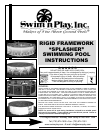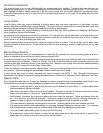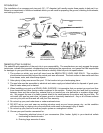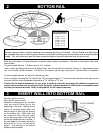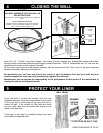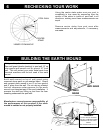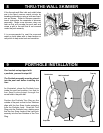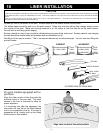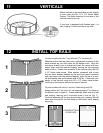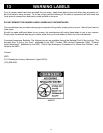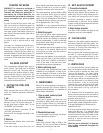11
TREATING THE WATER
WARNING: The information contained in
the following sections about Water
Treatment and Filtering are generalities. If
you acquire any of these materials, we
recommend that you follow the instructions
which accompany the given product
closely.
In order to keep the pool water clean and
clear, you must use a disinfecting agent. Its
role is to kill off any micro-organism and
bacteria contained in the water and to pre-
vent algae growth. Disinfection involves two
main factors: the water’s acidity (pH) and its
chlorine content.
The pH value indicates whether a given body
of water is acid or alkaline and to what
degree.
The water in a swimming pool must have a
pH value ranging between 7.2 and 7.6.
Beyond this level, the action of chlorine is
considerably inhibited and the water can
become irritating. If the pH value is below 7.2
the water is aggressive and can be the cause
of corrosion of the metal parts of pool appli-
ances.
CHLORINE CONTENT
This is measured in milligram-liters (mgl) of
active chlorine. This value must be situated
between 0.4 and 1 mgl. The water must be
tested for pH and chlorine values by colori-
metric analysis, using an analysis kit. We
strongly recommend that you replace the
kit’s reagents once a year. Observe the
instructions provided with the kit.
I - PUTTING THE POOL INTO
SERVICE
When reopening the pool or refilling it with
water, the following operations should be
performed:
1-pH
Check the pH value, which should be situated
between 7.2 and 7.6. Use the analysis kit. If
the pH value found is higher than 7.6, use
“pH MOINS” (pH decreaser);
If the pH value found is lower than 7.2, use
“pH PLUS” (pH increaser).
Comply with the dosages indicated on the
package.
2-Chlorine
Check the active chlorine value, which must
be at least 0.4mgl.
If the value found is lower than this, use
chlore rapide (rapid action chlorine) in gran-
ulated or tablet form in order to rapidly
rebuild the minimum active chlorine level.
For normal operating, place the 200g or 600g
chlore lent (slow action chlorine) chlorine
cakes in the skimmer (200g for 25 m3
water). The slow distribution of this chlorine
will keep the chlorine values of your pool sta-
ble for approximately 8 to 10 days.
WARNING: It is very important that chlorine
products be placed exclusively in the skim-
mer.
3-Stabilizing agent
Sun rays and warm water temperatures
decompose chlorine, largely imparing its dis-
infecting capacity and leading to increased
chlorine requirements. In order to eliminate
this problem, when filling the pool, use the
stabilisant stabilizing agent.
This operation need not be renewed as long
as the pool is not drained. Please see the
instructions provided with the technical
description of the product.
Please note that addition of too much stabi-
lizing agent will have a chlorine-inhibiting
effect. In this case, it suffices to eliminate 2
to 3% of the water in the pool every week,
preferably during cleaning operations.
4-Water-softening agent
If using hard water (containing lime), initial
treatment is very important. In order to pre-
vent lime deposits in the pool or in the filter,
use a water-softening or anti-liming product,
following the instructions on the package.
II - MAINTENANCE
When all the above operations have been suc-
cessfully performed (pH, Chlorine, stabilizing
agent and anti-liming agent), it
is
importante to
ensure proper maintenance:
1- Once a week, control pH and
chlorine levels.
The pH value is generally quite stable, but it can
be modified by adding water to the pool and by
the use of organic chlorine (e.g. Javel water or
Clorox), which often raises the water pH level and
decomposes rapidly.
2-Check chlorine level.
If it has dropped below 0.4mgl, use chlore
rapide (rapid action chlorine).
3-Check
(slow action chlorine; 200g or 600g) in the
skimmer. Do not wait for them to dissolve
entirely before adding the new ones.
III - ANTI-ALGATE TRETMENT
1-Preventive treatment:
At the dosage prescribed above, chlorine
also acts as an algicide. Stormy weather, fre-
quent use of the pool, faulty filtering are fac-
tors which can increase the rate of algae
formation, resulting in slippery, slightly
greenish walls. In this case, do not hesitate
to apply a high chlorine dosage and leave the
filter on around the clock.
2-High-dosage algicide:
If in spite of this measure the algae do not
disappear, use a very active algicide.
IV - FLOCCULATION
Certain very fine organic particles may not be
sufficiently filtered by sand filter action. The
use of a flocculating agent will enhance the
efficiency of filtering, thus eliminating all
suspended particles in pool water.
Start by putting the flocculating agent into
the filter. If it turns out that this is insuffi-
cient, perform flocculation directly in the
pool itself. Observe the instructions on the
package.
V - WINTER CARE
1. If thru wall skimmer inlet and outlets are
used, the skimmer must be blocked off with
a block off plate to prevent any water from
laying in the skimmer. The return fitting
must also be blocked off by using a plug on
the inside of the pool. It is very important
that the return fitting not protrude into the
pool and that water is not allowed to flow
into the skimmer. If this is not followed,
when the ice in your pool forms it will grab
onto your skimmer and return fittings, and if
the ice should shift it will rip your wall at
these locations.
2. A properly sized ice compensator (pool
pillow) must be secured in the pool water to
relieve the ice pressure that can exert severe
pressure on the pool wall.
3. Proper chemicals must be used in order to
prevent algae growth throughout the winter.
A strong concentration of chlorine and an
algaecide will help.
4. A cover must be used to keep out dirt and
debris from the pool. It is important when
securing the cover that enough slack is used
so that it rests on the top of the water so that
the pressure is not on the pool frame. A
build up of snow on the top of the cover
should be removed.
While the pool is winterized it is important
that it remain undisturbed throughout the
winter months.



